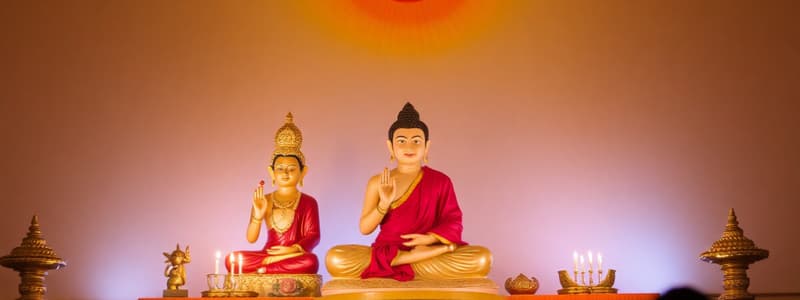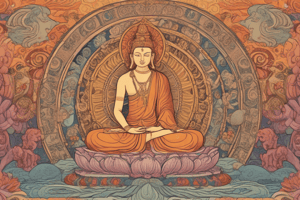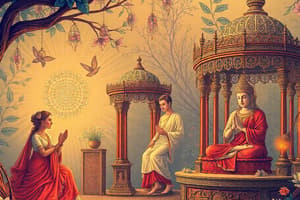Podcast
Questions and Answers
Which states in India have a high incidence of unemployment exceeding 10%?
Which states in India have a high incidence of unemployment exceeding 10%?
- Bihar
- Goa (correct)
- Maharashtra
- Kerala (correct)
Which of the following states are identified as having weak industrialization?
Which of the following states are identified as having weak industrialization?
- Karnataka
- Madhya Pradesh (correct)
- Kerala (correct)
- Tamil Nadu
What is a significant reason for income inequalities in India?
What is a significant reason for income inequalities in India?
- Financial inclusion gaps (correct)
- High wages in urban areas
- Development of skill-based industries
- Employment rate discrepancies (correct)
In which state do females outnumber males according to the gender ratio?
In which state do females outnumber males according to the gender ratio?
Which states show lower life expectancy for females compared to males?
Which states show lower life expectancy for females compared to males?
What percentage of India's population lives in rural areas according to Census 2011?
What percentage of India's population lives in rural areas according to Census 2011?
Which of the following states is described as having the worst gender ratio?
Which of the following states is described as having the worst gender ratio?
What is a characteristic feature of Indian villages?
What is a characteristic feature of Indian villages?
Which of the following is NOT one of the five ‘Ks' in Sikhism?
Which of the following is NOT one of the five ‘Ks' in Sikhism?
What is the ultimate spiritual goal in Buddhism known as?
What is the ultimate spiritual goal in Buddhism known as?
Which of the following is NOT one of the Four Noble Truths in Buddhism?
Which of the following is NOT one of the Four Noble Truths in Buddhism?
Who is considered the 24th Tirthankar in Jainism?
Who is considered the 24th Tirthankar in Jainism?
Which two sects represent the major divisions in Jainism?
Which two sects represent the major divisions in Jainism?
What is the holy book of Buddhism called?
What is the holy book of Buddhism called?
In Jainism, which of the following is emphasized as a guiding principle?
In Jainism, which of the following is emphasized as a guiding principle?
What is the primary characteristic of the teachings that were revealed to Moses in Judaism?
What is the primary characteristic of the teachings that were revealed to Moses in Judaism?
What is the primary occupation of the majority of rural people in India?
What is the primary occupation of the majority of rural people in India?
How is the population distributed in rural areas of India?
How is the population distributed in rural areas of India?
What percentage of India's total population lived in villages as per the 2011 census?
What percentage of India's total population lived in villages as per the 2011 census?
What is a common characteristic of social interactions in Indian villages?
What is a common characteristic of social interactions in Indian villages?
Which of the following best describes the literacy rate in rural areas compared to urban areas in India?
Which of the following best describes the literacy rate in rural areas compared to urban areas in India?
What role do rural women in India predominantly play within their families?
What role do rural women in India predominantly play within their families?
Which of the following statements best reflects the general attitude of people in Indian villages?
Which of the following statements best reflects the general attitude of people in Indian villages?
Why are women in rural India highly reliant on family institutions?
Why are women in rural India highly reliant on family institutions?
What sector employs the majority of the urban population?
What sector employs the majority of the urban population?
How does the unemployment rate in urban areas compare to that in rural areas as of 2011-12?
How does the unemployment rate in urban areas compare to that in rural areas as of 2011-12?
Which form of media has the lowest penetration among the urban population?
Which form of media has the lowest penetration among the urban population?
What was the percentage of people living below the poverty line in urban India in 2011-12?
What was the percentage of people living below the poverty line in urban India in 2011-12?
Which factor contributes to poverty in urban areas?
Which factor contributes to poverty in urban areas?
What issue is NOT mentioned as a main problem faced by the urban population?
What issue is NOT mentioned as a main problem faced by the urban population?
What is the work participation rate for female workers in urban areas?
What is the work participation rate for female workers in urban areas?
What term is often used to refer to tribes due to their original habitat?
What term is often used to refer to tribes due to their original habitat?
What is the unemployment rate in rural areas according to the Current Daily Status (CDS) as per 2011-12 estimates?
What is the unemployment rate in rural areas according to the Current Daily Status (CDS) as per 2011-12 estimates?
Which factor is NOT listed as a cause of rural poverty?
Which factor is NOT listed as a cause of rural poverty?
Which percentage indicates the work participation rate for females in rural areas?
Which percentage indicates the work participation rate for females in rural areas?
What is the main characteristic of media exposure in rural areas compared to urban areas?
What is the main characteristic of media exposure in rural areas compared to urban areas?
As per 2011-12 estimates, which state is NOT identified as having high rural poverty?
As per 2011-12 estimates, which state is NOT identified as having high rural poverty?
Which of the following represents a significant issue faced by the rural population?
Which of the following represents a significant issue faced by the rural population?
Which estimate shows a lower unemployment rate for urban areas based on the Usual Principal and Subsidiary Status (UPSS)?
Which estimate shows a lower unemployment rate for urban areas based on the Usual Principal and Subsidiary Status (UPSS)?
What do the Current Weekly Status (CWS) and Usual Principal and Subsidiary Status (UPSS) measures of unemployment primarily assess?
What do the Current Weekly Status (CWS) and Usual Principal and Subsidiary Status (UPSS) measures of unemployment primarily assess?
Flashcards are hidden until you start studying
Study Notes
Major World Religions
- Hinduism: Oldest religion in the world, followed by the largest number of people in India. The holy book is the Vedas.
- Islam: Second largest religion in the world, followed by the second largest number of people in India. Holy books are the Quran and Hadiths.
- Christianity: Third largest religion in the world, followed by the third largest number of people in India. Holy book is the Bible.
- Sikhism: Founded by Guru Nanak and further developed by the nine Gurus after him. Holy book is the Guru Granth Sahib. Sikhs wear five K's.
- Kesh (hair)
- Kangha (comb)
- Kara (bracelet)
- Kirpan (sword)
- Kachha (shorts)
- Buddhism: Founded by Lord Gautam Buddha. 85% of Buddhists in India live in Maharashtra.
- Two major schools of thought: Hinayana and Mahayana
- Holy book is the Tripitaka
- The goal of Buddhism is to achieve Nirvana (enlightenment).
- The Four Noble Truths
- All existence is dukkha - Human life is full of struggle or sorrow
- The cause of dukkha is craving - Desire is the root cause of sorrow
- The cessation of dukkha comes with the cessation of craving - Removal of desire leads to removal of sorrow
- There is a path that leads from dukkha – There is a path (Eightfold Path) that helps to remove sorrow and attain nirvana
- The Eightfold Path
- Right view
- Right intention
- Right speech
- Right action
- Right livelihood
- Right effort
- Right mindfulness
- Right concentration
- Jainism: Followers are mostly located in Maharashtra, Gujarat and Rajasthan.
- Preached by Lord Mahavira, the 24th Tirthankar of Jainism.
- Texts containing Lord Mahavira’s teachings are called Agamas
- Two sects: Digambar and Shwetambar
- Three guiding principles:
- Right Perception (Samyak Darshana)
- Right Knowledge (Samyak Jnana)
- Right Conduct (Samyak Chritra)
- Five main vows:
- Ahimsa (Non-violence)
- Satya (Truth)
- Asteya (Not stealing)
- Brahmacharya (Chastity or Celibacy)
- Aparigraha (Renunciation or Detachment)
- Judaism: Religion, philosophy and way of life of Jewish people.
- Based on God’s laws revealed to Moses on Mount Sinai
Regional Imbalances in India
- Unemployment: Highest in literate states of Kerala, Goa, Tamil Nadu, and lower in poorer states like Orissa, Bihar, Madhya Pradesh, and UP.
- Industrialization: Maharashtra, Gujarat, Tamil Nadu, and Karnataka have made progress, whereas, northeastern states lag behind.
- Income Inequalities: Highly populated states like Bihar, Madhya Pradesh, Rajasthan, and UP have glaring income inequalities.
- Reasons include: unemployment, low wages, and lack of financial inclusion.
- Gender-Ratio: Kerala has a higher proportion of females than males. Haryana has the worst gender ratio.
- Life Expectancy: Kerala has a higher life expectancy for females, whereas, Bihar, Madhya Pradesh and UP have a higher life expectancy for males.
Rural Characteristics
- India is a land of villages with 68.84% of the population living in them.
- Caste System: Widespread in villages, with each village having several castes.
- Interdependence of castes due to specialized occupations.
- Intimate Relations: Face-to-face relations among people with close relationships.
- Due to small population and regular interactions.
- Status of Women: Dependent on men, working indoors and in fields, and attached to family.
- Occupation: Mostly engaged in agriculture.
- About 80% of villagers are connected to agriculture.
- Size of the Population: 68.84% of the population lives in villages, higher compared to developed countries.
- The reason behind this high proportion is due to the developing nature of the Indian economy and majority of the workers being engaged in agriculture.
- Location Pattern: Population is scattered.
- Only about 4000 villages have a population of 10,000 plus.
- In 2,36,000 villages, the population is less than 500 persons.
- Literacy: Lower than the urban population, with a rate less than 50% in many states.
- Due to lack of facilities and poverty.
- Conservative Attitude: People are resistant to change, leading to backwardness in most villages.
- Unemployment Rate: High on CDS basis, with 5.7% of the workforce unemployed as compared to 5.5% in urban areas.
- Media Exposure: Lower than the urban population.
- Due to poverty and lack of education.
- Poverty: 25.70% of rural people live below the poverty line, especially in Orissa, Bihar and Madhya Pradesh.
- Causes include: high population growth, social exploitation, poor implementation of anti-poverty measures.
- Work Participation Rate: Similar to the urban population for males.
- Significantly higher for females (30%) compared to urban areas (15.4%)
Urban Characteristics
- Urban Population: Mostly engaged in the services sector followed by the secondary sector.
- Unemployment: Declining on CDS basis, with 5.5% on the CDS basis in 2011-12.
- Media Exposure: High, with most of the population exposed to radio, TV and internet.
- Poverty: Lower than the rural population, with 13.70% of people living below the poverty line.
- Causes include: unemployment, large families, and social evils.
- Work Participation Rate: Similar for males (53.8%) but lower for females (15.4%) as compared to rural areas.
Tribal Characteristics
- Tribes are communities occupying common geographic areas with a common language and culture.
- Often called ‘Girijans' due to their origin in jungles and hilly regions.
Studying That Suits You
Use AI to generate personalized quizzes and flashcards to suit your learning preferences.




